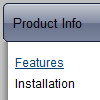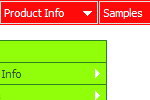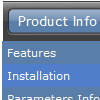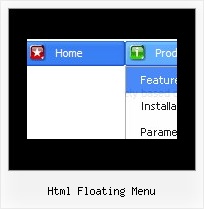Recent Questions
Q: Where can I give the body of the javascript method which I use in cool dhtml menu?
A: You can define functions after menuItems, before you call dm_init();function.
var menuItems = [
["text", "javascript:your_function(...)", ...]
];
Where your_function(...):
function your_function(...)
{
.....
}
Q: I should mean the font style that I failed to update after I have selected and assign font as shown in the pic above.
Step 1. using the sample data file
Step 2. select the font section of the Parameter Step3. click the font style and a window box will show up all the installed fonts
Step4. the default font is Tahoma, so I change it Times Roman
Step5. select Times Roman and click the Assign Font button There is no response with or without option Auto
The style font box did not update nor the preview
A: You should click OK button, not "Assign Font" button when you choosethe font. It is possible that you have to click "Update" button on the"Preview" window.
Q: How do I change the font style for menus to bold, but leave the sub-menus normal in the html navigation bar?
I understandthere’s a “fontStyle” variable, but is there an “itemfontStyle”?
A: You can use Individual Item styles to set specific parameters for eachitem or submenu.
var fontStyle=["normal 9pt Verdana","normal 9pt Verdana"]; //for subitems
//style for the top items:
var itemStyles = [
["itemHeight=21px","itemBackColor=#F2F3F2,#1665CB","fontStyle='bold 9pt Verdana','bold 9pt Verdana'"],
];
Q: I recently downloaded the trial version of Deluxe Menu-Deluxe Tree and Deluxe Tabs. I am very, very pleased with your product!! I wish to purchase Deluxe Menu & Tree & Tabs & Popup Window & Calendar Single Website License Product # 300094393.
However, before I do, I have a few questions first.
Question #1
I created a DeluxeTree Menu that is very large due to the amount of pages in my website and tested it on my website. It works fine. Of course I have created and saved a .js file and still have to add much more submenus to it. When I purchase the full version of javascript context menu will and begin to modify this .js file that I created will the "Trail Version" logo disappear? I hope so because it would be quite a task to have to re-create this file.
Question #2
I also created a Deluxe Menu in a cross frame structure and placed the menu in the top frame. When I tested it and click on the menu button, the submenus drop down but do not appear in the frame below. They remain in the top frame forcing me to resize the top frame to see the submenus. When I viewed the example on your website for the cross frame structure, the examples show the submenus overlapping and appearing on the frame below the top frame. How do I fix this?
Thank you for time, looking forward to purchasing your product.
A: 1) There is no need to create your javascript context menu after the purchase.
You'll use new engine files only.
The purchased version of Deluxe Menus doesn't have nag messages.
You'll see "Incorrect Key" message on a local machine but you won't see it on a registered domain.
2) You should install the menu in a cross-frame mode, see more info here:
http://www.deluxe-menu.com/cross-frame-mode-sample.html
Click "Show additional info" button.










